Table of Contents
Have you ever heard of wood chips as a perfect mulch for your gardening endeavors? If not, you have come to the right place. The gardening wood chips are as important as the gardening tools for the well-being of your backyard oasis. Not only do they add moisture and organic matter to the seeds and plants, but they also act as versatile resources. The chipped branches and leaves make up a perfect source of nutrients for your herbs and plants. So, for those who love gardening, this article is here to help as we’re covering detailed discussions on the power of gardening wood chips. So, without further ado, let’s get into the guide of wooden mulch.
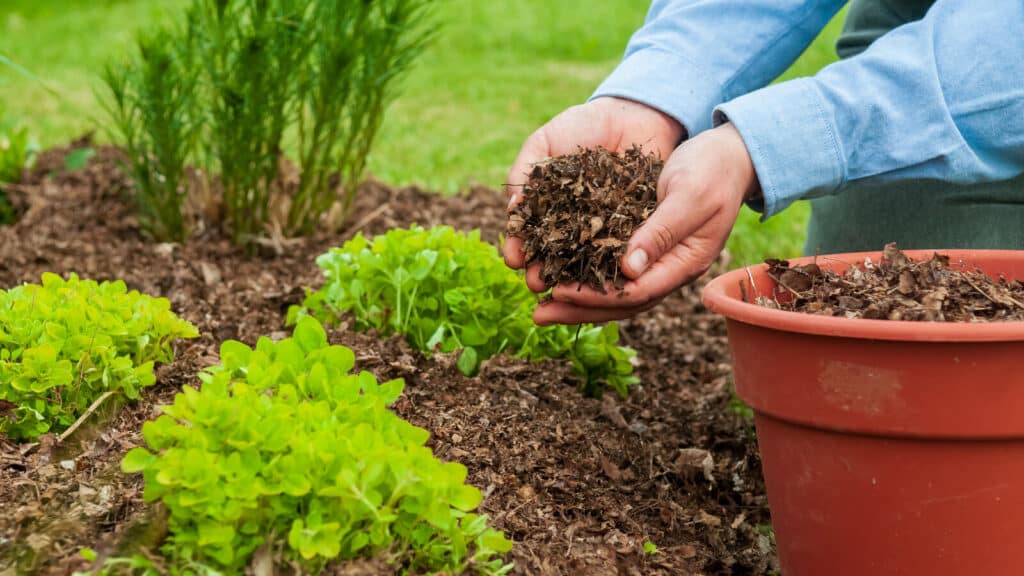
Gardening Wood Chips: Grasp the Concept
Ah, the gardening wood chip, so simple yet so powerful; the unsung hero of the vegetable patch, the arboreal champion of the backyard jungle, and the saving grace of many a sore gardener’s knees. However, precisely what are these enchanted bits of delight from the forest? Together, let’s peel off the bark to reveal the secrets inside.
Wood chips for gardening are a result of a tree’s transition from grand monarch to practical mulch. These chips, made by tree service experts or astute gardeners themselves, are a jumble of bark, branches, and occasionally even a stray leaf or two. But hidden among this eclectic group is a wealth of wonderful garden things. They keep weeds out and preserve valuable moisture by acting as a barrier for wood chip paths and a comfortable blanket for vegetable beds. Moreover, they gradually release minerals throughout their decomposition, one of which is a much-needed source of nitrogen. This enriches the soil and promotes healthy plant development. So, keep this in mind the next time you’re considering what your garden needs: mulching with wood chips isn’t just sensible; it’s delightfully arboretum-al!
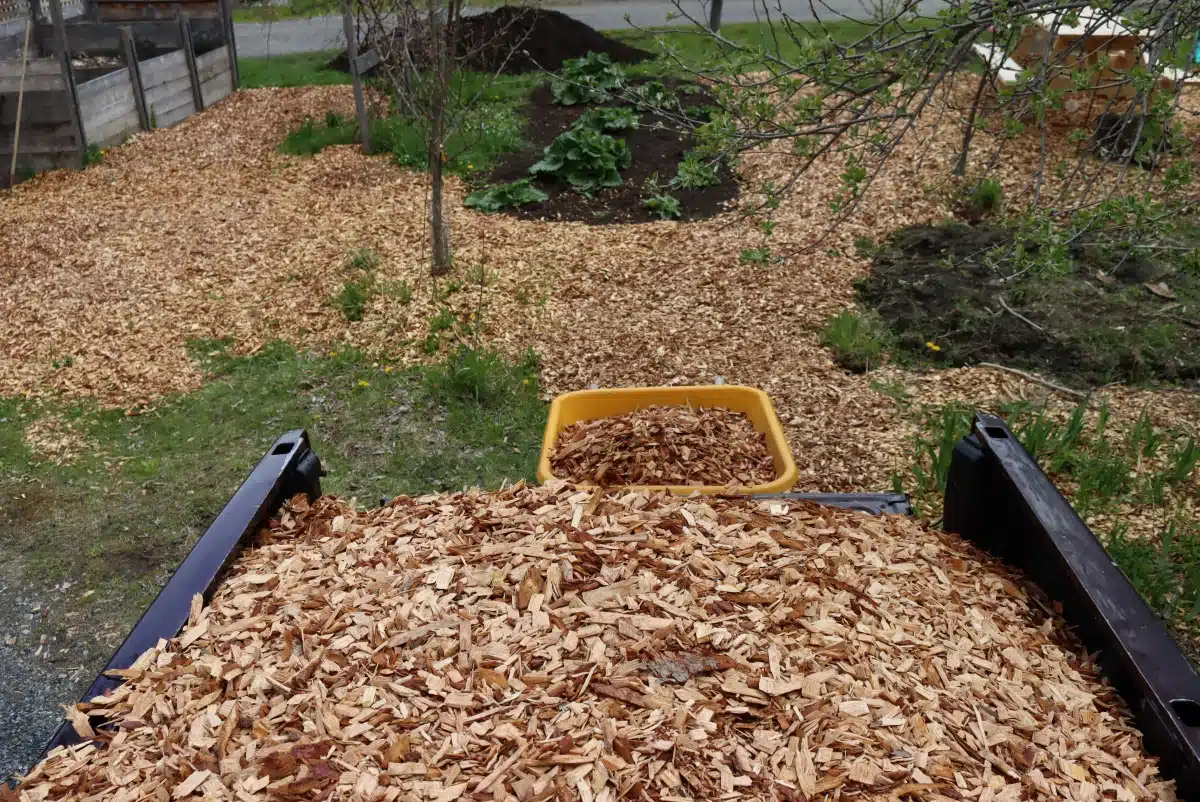
What are Gardening Wood Chips Made of?
A question might be popping up in your mind what materials are included in wood chips for garden paths? Don’t worry we are here with the answer.
Here is a breakdown of the materials that together form the mulch:
1. Tree Byproducts Make Gardening Wood Chips
- Bark, branches, and even leaves are among the byproducts from trees that make up gardening wooden mulch. These products are frequently purchased from arborists, landscaping firms, and tree removal services. One important resource that can be acquired from this procedure is wood chips for plants.
2. Chipping Process
- To make the tree byproducts smaller, more uniform pieces that can be mulched, they go through a chipping process.
- The larger tree pieces are often broken down into smaller chips using chippers or shredders. This finely processed mulch is ideal for vegetable beds and raised beds.
3. Various Wood Types are Included in Gardening Wood Chips
- Hardwoods (such as oak, maple, and beech) and softwoods (such as pine and cedar) can be used to make wooden mulch for gardens.
- Certain wood species may have distinctive qualities, such as differing acidity levels and rates of disintegration. Various tree species can yield wood chip mulch that offers a range of advantages for garden soil.
4. Inclusion of Bark is Important in Gardening Wood Chips
- The bark is frequently added to gardening wooden mulch, which enhances the mulch’s beauty and texture.
- Crushed or chipped bark can help inhibit the growth of weeds while also adding visual appeal to mulched areas. Under mulch, landscaping fabric can be used to further prevent weed growth while enhancing appearance.
5. Optional Additives Enhance the Mixture of Gardening Wood Chips
- For certain uses, some wooden mulch products for gardening can include extra additives.
- Mulch blends, for instance, can include manure, compost, or other organic materials to improve microbial activity and soil fertility. The addition of organic compounds to mulch improves the soil’s water retention.
6. Natural Coloring Procedures to Add Hues in Gardening Wood Chips
- To obtain particular colors, gardening wooden mulch occasionally goes through coloring procedures.
- To obtain hues like red, black, or brown, one can use iron oxide paints or natural dyes, which will improve the mulch’s visual appeal. In addition to improving beauty, colored mulch has the potential to offer supplementary advantages like moisture retention and UV protection.
7. Environmental Considerations
- Wood mulch for gardening should be devoid of pollutants and dangerous substances in order to comply with environmental regulations and support sustainability.
- Mulch made from untreated wood is preferable because it is safer for the soil, plants, and beneficial creatures. Although landscape fabric is frequently used, it’s crucial to make sure that it doesn’t obstruct water circulation and soil organisms’ natural activities.
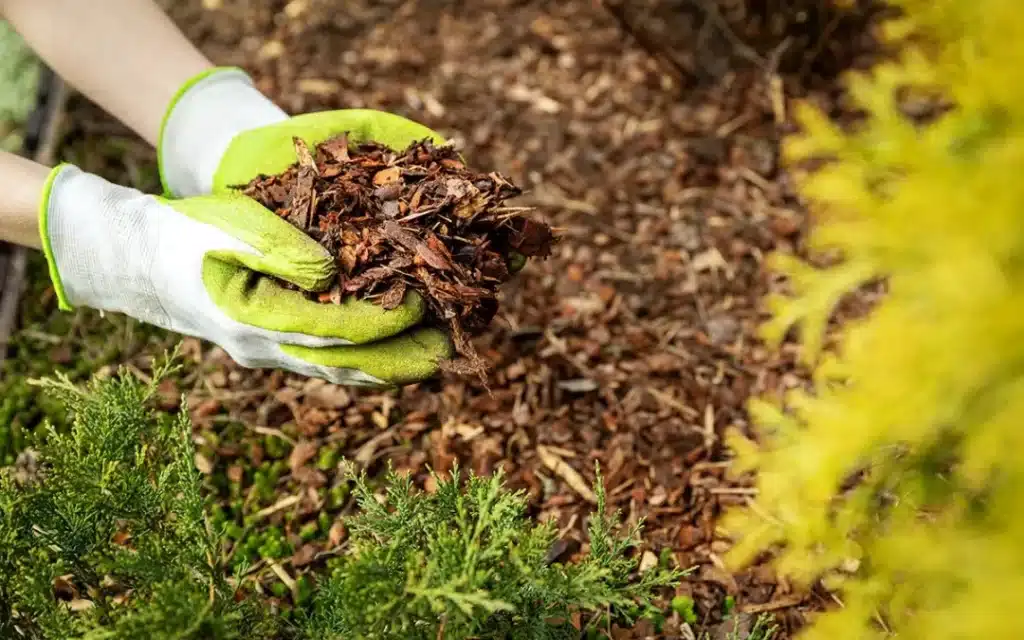
Advantages of using Gardening Wood Chips
Do you know that wood chips for plants offer several advantages and benefits for gardeners? Yes, from improving overall soil health to preserving water and erosion control; wooden chips prove to be greater mulch for herbs and plants. Let’s go through the detailed benefits of wooden chips.
1. Gardening Wood Chips Helps in Enhancing Soil Health
The first advantage is that Gardening with Wood Chips is a great way to boost soil health organically. Soil microorganisms find fresh wood chips to be a good source of carbon. But it’s important to remember that during the earliest stages of decomposition, fresh wood chips tie up nitrogen. Gardeners can combat this by adding blood meal or another nitrogen-rich supplement to the soil. Additionally, as wood chips decompose over time, they release nutrients like potassium, phosphate, and nitrogen that enhance soil structure and fertility.
2. Water Conservation
Mulching your garden with wood chips provides a number of advantages for water conservation. By lowering soil surface evaporation, wood chips preserve moisture and cut down on the frequency of watering. Moreover, gardeners in areas with little rainfall can benefit greatly from this water-saving method. Wood chips are a multipurpose tool in sustainable gardening methods since they not only help to retain soil moisture but also promote soil health and discourage weed growth.
3. Gardening Wood Chips Prevent Weed Growth
By constructing a barrier that prevents weed growth, wood chips are essential to weed suppression. Even while wood chips initially bind nitrogen during their decomposition, their ability to screen sunlight efficiently suppresses weed germination and establishment. Furthermore, weed seedlings are kept from competing with desired plants for vital resources by the thick layer of wood chips. Additionally, by using less chemical herbicide, this natural weed control technique helps to maintain a healthier and more ecologically friendly garden ecosystem.
4. Soil Temperature is Regulated by Gardening Wood Chips
Gardening with wood chips helps with the year-round creation of ideal soil temperatures for plant growth. Wood chips protect plant roots from intense heat or cold in addition to insulating the soil and moderate temperature swings. It’s crucial to remember that although wood chips help keep the soil cooler in hot weather, they can also store moisture, which in certain situations might result in excessive humidity. However, these possible negative effects can be minimized, and ideal growing conditions for plants can be guaranteed with the correct management of wood chip mulch.
5. Gardening Wood Chips Offer Erosion Control
In garden settings, wood chips are a practical remedy for erosion control. Furthermore, wood chips help in maintaining soil structure and preventing erosion by reducing the impact of rainfall and slowing down water runoff. Wood chips temporarily bind nitrogen, but their long-term advantages exceed this drawback. In addition, wood chips help with soil structure and water retention, which makes them an excellent addition to areas that are prone to erosion, such as garden walks and slopes.
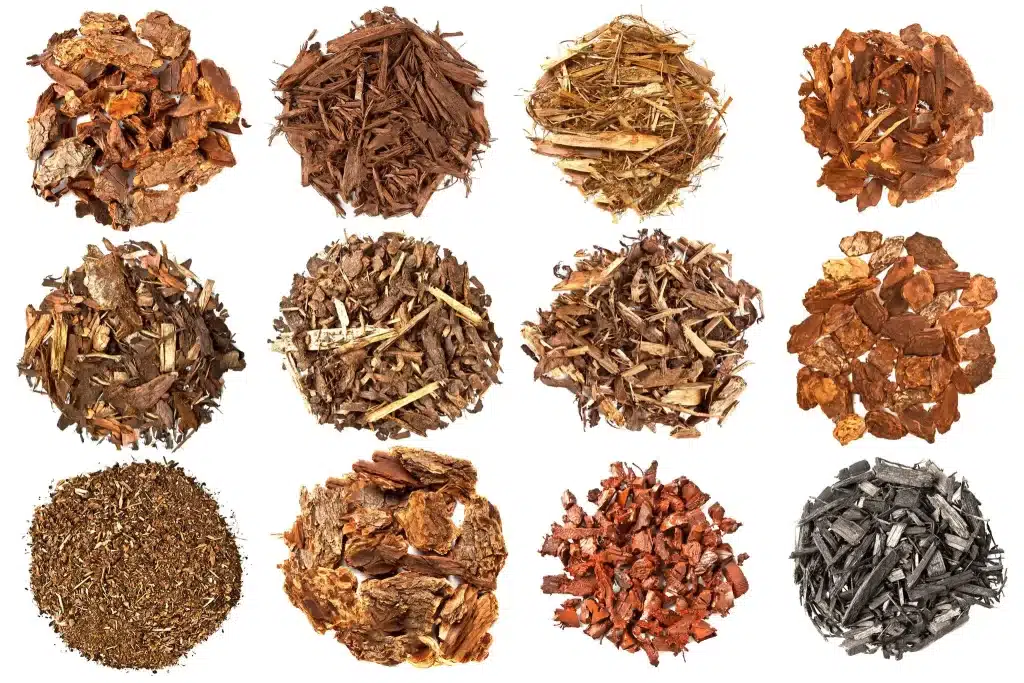
Types of Gardening Wood Chips
Coming towards the next part, there are certain types of wood chips for gardens. We’ll discuss each type in detail.
1. Hardwood Chips: Common Gardening Wood Chips
- Description: Hardwood chips come from deciduous trees and have a dense structure that decomposes gradually. This gradual breakdown rate guarantees a mulching effect that lasts for a long time.
- Benefits: Hardwood chips provide significant advantages for soil enrichment beyond their longevity. As they decompose, important elements like potassium, phosphorus, and nitrogen are released into the soil, supporting healthy plant growth. In addition to being great at suppressing weeds and retaining moisture, their sturdy construction makes them perfect for tree rings, perennial beds, and landscape projects that call for long-term mulch stability.
2. Softwood Chips: Light Textured Gardening Wood Chips
- Description: Evergreen tree-sourced softwood chips have a lighter texture and break down more quickly than their hardwood counterparts.
- Benefits: Softwood chips are beneficial to plants since they release nutrients quickly, even if they don’t last as long. Vegetable gardens, annual beds, and places that need regular mulch replenishment are good uses for them. Because of their decreased weight, which makes them easier to spread and handle, gardeners who want ease without compromising effectiveness frequently choose them.
3. Aromatic Chips
- Description: Aromatic chips infused with natural oils and compounds from trees such as cypress or cedar give off a nice scent that keeps pests away and gives the garden a new smell.
- Benefits: These chips not only have aromatic qualities but also deter ants, ticks, and mosquitoes, which lessens the need for chemical pesticides. Because of their inherent repellent properties, they are a great option for garden areas—like the areas surrounding patios, outdoor dining areas, and relaxing areas where pest control is the primary concern.
4. Colored Chips
- Description: To obtain a specific hue, colored chips are colored using natural pigments or dyes, which improves the aesthetic appeal of garden scenes.
- Benefits: In addition to being aesthetically pleasing, colored chips provide useful properties like moisture retention and UV protection. Additionally, they can aid in defining distinct sections of the garden by offering visual indicators for borders, walkways, and focal points. Furthermore, colorful chips can be employed to enhance the garden’s general design plan and provide outdoor areas with more flare and individuality.
5. Organic Blend Chips: Nutrient Rich Gardening Wood Chips
- Description: To make a nutrient-rich mulch mixture, organic blend chips combine several types of wood with extra organic elements like compost or manure.
- Benefits: This mixture offers a balanced combination of nutrients, organic matter, and advantageous microbes, providing a comprehensive approach to soil enrichment. Chips made from an organic blend improve plant life, retain moisture better, and support healthy soil. They are very helpful for reviving garden beds, restoring worn-out or depleted soil, and encouraging sustainable gardening techniques.
6. Recycled Wood Chips: A Reclaimed Resource in the Form of Gardening Wood Chips
- Description: Made from salvaged or recycled wood, reclaimed chips help contribute to environmental sustainability by keeping trash out of landfills.
- Benefits: Recycled wood chips have the same advantages as regular wood chips in terms of weed control, moisture retention, and soil enhancement, in addition to being environmentally friendly. Gardeners can benefit from mulch’s practical benefits and lessen their ecological footprint by utilizing recycled materials, which also supports recycling activities. The ideas of sustainability and resourcefulness in gardening operations are demonstrated with recycled wood chips.
Gardeners can make informed choices based on their own needs, preferences, and gardening goals by being aware of the special features and advantages of each variety of wood chips. Whatever your gardening style and goal, there is a wood chip variety to fit your needs, be they long-term, visually appealing, useful, or environmentally conscious.
You can find detailed information about types of Wood chips in Sarah Jay’s blog.
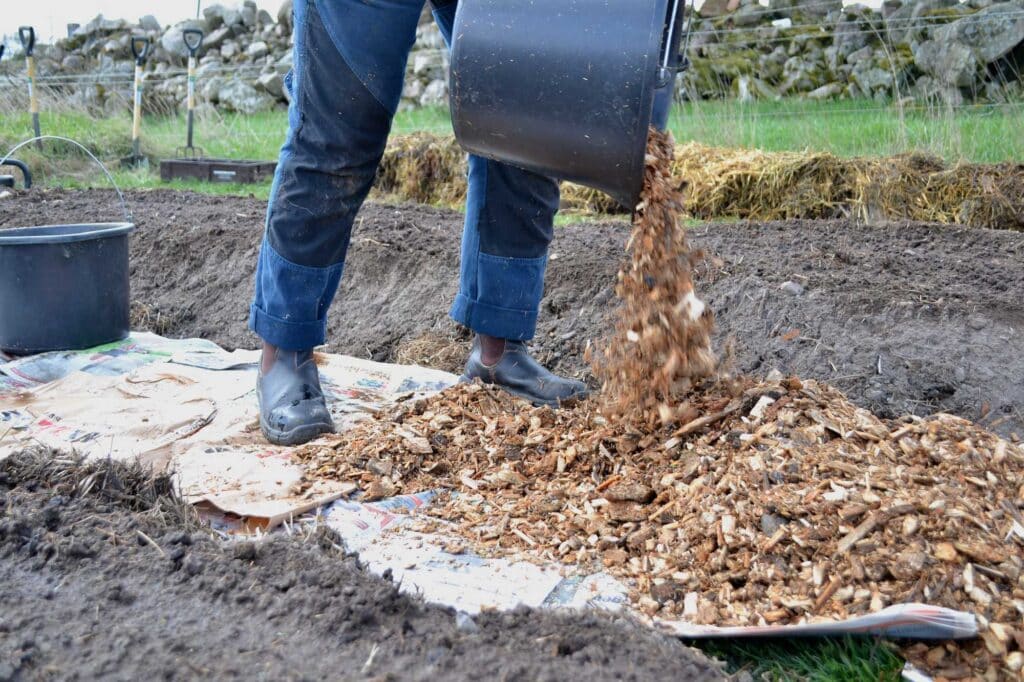
How to Use Gardening Wood Chips?
Are you ready to transform the health of your plants with the ultimate gardening techniques with wood chips? If yes, let’s go through the detailed guide on how to use the wooden mulch for the improvement of herbs. This covering of soil is going to transform ordinary plant growth into what you call an ideal verdant scenery. So, without any further ado, let’s see how to make the most of wood chip mulch.
1. Set Up the Space for Gardening Wood Chips
It’s important to sufficiently prepare the soil surface before mulching. This means taking away any existing rocks, garbage, or weeds. Removing weeds makes room for mulching since they are a rival to plants for nutrients, moisture, and sunlight. By clearing away debris, you can make sure that the wood chips are in close touch with the soil, which promotes moisture retention and nutrient exchange. You can set up the area in a way that will allow the wood chips to give your plants the most benefits possible.
2. Select the Right Kind and Quantity of Gardening Wood Chips
For mulching to be successful, the right kind and amount of wood chips must be chosen. Think about things like your plants’ particular requirements, the look you’re going for, and the local climate. Hardwood chips, on the other hand, disintegrate more quickly and are better suited for annual beds or vegetable gardens. Hardwood chips are more resilient and break down more slowly, making them perfect for long-term mulching. The right amount must be calculated according to the area to be mulched, the depth that is desired, and other factors to guarantee adequate covering, weed suppression, and moisture retention.
3. Use Weed Barrier
Using a weed barrier, such as landscaping fabric, is not usually necessary but can be helpful, particularly if weed control is an issue. By stopping weed seeds from sprouting and spreading through the mulch layer, the weed barrier lessens resource competition and the need for regular weeding. This can be especially useful in garden beds where you wish to reduce maintenance and concentrate on plant growth or in places where weeds are a persistent problem. Weeds are kept at bay by applying a weed barrier prior to mulching, which forms a barrier between the soil and the wood chips.
4. Spread the Gardening Wood Chips
Now that the space is ready, uniformly distribute the wood chips across the soil’s surface. Spread the mulch to the appropriate depth with a shovel, rake, or pitchfork, making sure to cover the entire area without any clumps or exposed areas. For the mulched area to consistently retain moisture and control weeds, it is imperative that the wood chips be applied evenly. Take care not to suffocate or cause rot in plants by burying their bases or covering perennials’ crowns with mulch. When wood chips are spread properly, they will benefit your plants to the greatest extent possible while preserving a wholesome growing environment.
5. Create Mulch-Free Areas to Avoid Direct Contact with Stems
Mulch-free zones are created around plant bases by leaving a tiny space of exposed soil; this keeps wood chips from coming into direct contact with plant stems or trunks. This is crucial because mulch that comes into close touch with plant trunks or stems can retain moisture and foster an environment that is conducive to decay or disease. You can make sure that your plants stay healthy and don’t experience problems with moisture by establishing areas free of mulch. Mulch-free zones also promote overall plant health and longevity by acting as a barrier against soil-borne diseases and as a deterrent to pests.
6. Garden Borders and Mulch Paths
Consider applying wood chips to delineate borders or walkways in your garden in addition to mulching your vegetable beds. Mulched pathways offer the garden practical advantages, including erosion management and weed suppression, in addition to aesthetic appeal. Mulching walkways reduces upkeep and improves soil health in addition to creating a neat, well-defined area for walking. Mulched garden borders define distinct garden sections and produce a unified design, giving the landscape shape and coherence. Mulching borders and walkways improve the garden’s overall appearance while offering practical advantages for plant development and soil preservation.
7. Spray the Mulched Area with Water
After that, provide the mulched area with plenty of water once you are done applying the wood chips. This ensures that your plants have access to enough water by helping the mulch to settle into its proper spot and encouraging soil moisture retention. Additionally, watering starts the breakdown process, which lets nutrients slowly seep into the soil and help your plants. After mulching, it’s crucial to water plants properly because dry spells and hot temperatures can make plants more vulnerable to drought stress. You can offer your plants the best growing conditions possible and encourage healthy growth and vitality by watering the mulched area.
8. Observe and Uphold the Mulched Area with Gardening Wood Chips
The next step is to frequently check on and maintain the mulched area after the wood chips are installed. This entails weed detection, soil moisture monitoring, and necessary mulch depth adjustments. Weeds compete with your plants for resources when they are removed early, and it also keeps the garden looking neat. By keeping an eye on the moisture content of the soil, you can make sure that your plants receive enough water, particularly in dry or hot weather. Maintaining adequate coverage, efficacy in suppressing weeds, and moisture retention can all be achieved by adjusting the mulch level as necessary to keep your plants happy and healthy.
9. Modify and Upkeep
It’s important to monitor how the wood chips impact soil properties and plant health during the growing season. Make necessary adjustments to your mulching techniques if you observe any problems, such as inadequate drainage, waterlogging, or an overabundance of weed growth. This could entail clearing out extra mulch from places where it has gathered or adding more wood chips to regions where the mulch has thinned out. You can improve the growing circumstances of your plants and guarantee their ongoing health and vigor by modifying your mulching techniques as necessary.
You can use gardening wood chips to improve the overall sustainability, look, and health of your garden by following these instructions and being meticulous. Using the right mulching techniques can help maintain a healthy garden environment by encouraging plant growth, preserving soil moisture, and requiring less upkeep. There are several advantages for you and your plants when you use wood chips in your garden landscape, whether you’re mulching flower beds, vegetable gardens, or walks.
Conclusion
Summing it up, there are several advantages to using gardening wood chips for gardeners, including improved soil health, water conservation, and erosion prevention. Gardeners can create flourishing garden landscapes by having a thorough understanding of their types, composition, and proper use. Gardeners can grow colorful, healthy gardens and encourage environmental responsibility and sustainability by using the power of wood chips.
Mulch Magic: Transform Your Garden with Wood Chips!
